[IFA 2022] TCL CSOT (Mini LED TV, QLED TV, Smart home appliances)
#ifa2022 #tcl #tcltv

https://ubiresearch.com/en/

https://en.olednet.com/

marketing@ubiresearch.com
+82-2-577-4391
#ifa2022 #tcl #tcltv

https://ubiresearch.com/en/

https://en.olednet.com/

marketing@ubiresearch.com
+82-2-577-4391
We analyzed the prices of 65-inch TVs of Samsung Electronics’ QLED TVs, OLED TVs from LG Electronics and Sony, and LG Electronics’ QNED TVs until March 2022.
The models we investigated at Samsung Electronics were 4K high-end model QN90A, 4K entry-level models QN85A and QN80A, and 8K models QN800A and QN900A. The models at LG Electronics were OLED TVs A1, C1, and G1 models and QNED TVs QN90UP and QN99UP. The models at Sony Electronics were OLED TV XR65A80J and XR65A90J.
The prices of Samsung Electronics’ 4K models QN90A, QN85A, and QN80A were $2600, $2200, $1700, respectively and the 8K models QN900A and QN800A were $5000 and $3500, respectively. The launch prices of LG Electronics’ OLED TVs A1, C1, and G1 were $2000, $2300, and $3000, respectively while the QNED TVs QNED90UP and QNED99UP were $1600 and $2700, respectively. Sony’s OLED TVs XR65A80J and XR65A90J were priced at $2800 and $4000, respectively.
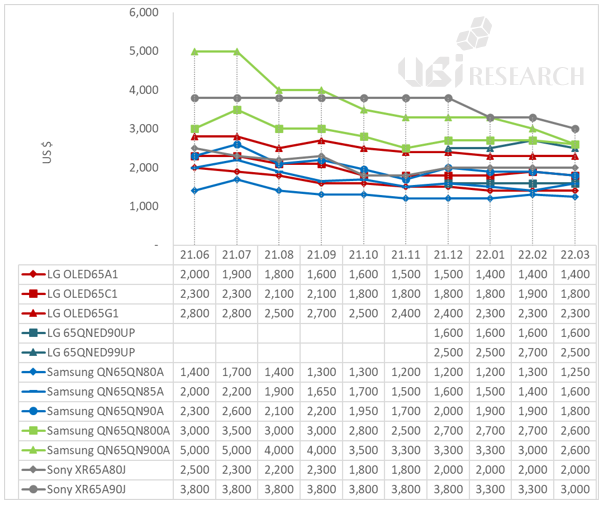
As of March, the highest-priced 65-inch premium TV model was Sony’s XR65A90J. The lowest-priced model was Samsung Electronics’ QN65QN80A.
The prices of most of Samsung Electronics’ products have been falling since December. As of March, Samsung Electronics’ 80A, 85A, and 90A models are priced at $150, $200, and $500 lower than LG Electronics’ A1, C1, and G1 models, respectively, to induce consumption.
The price of LG Electronics’ OLED A1 and G1 models did not change after the last $100 price reduction in January and the C1 model has maintained the price of $1800 since October 2021. The price of LG Electronics’ QNED90UP did not change and the QNED99UP maintained a price of $2500, down $200 from its launch price.
Sony’s XR65A80J, which had dropped to $1800 in October 2021, recovered to $2000 in December and has maintained it until March. The XR65A90J has been steadily dropping in price since December 2021, forming a price of $3000 in March.
On Black Friday, the day of the biggest sale season in the US, LG Electronics and Sony have lowered the price of 65-inch OLED TVs from the previous month, further increasing price competition in the premium TV market. On the other hand, 55-inch and 77-inch OLED TV prices are the same except for Sony’s XBR77A9G.
In November, LG Electronics’ OLED 65C9, a 65-inch OLED TV, was priced at US $ 2,100, down 12.5% from October’s US $ 2,400. Sony’s XBR65A8G’s November price was US $ 2,000, down 13% from the October price of US $ 2,300. Both models ship the same price at US $ 3,500.
Samsung’s QN65Q90, a 2019 QLED TV, is priced at US $ 2,200 in November, down 15.4% from the October price of US $ 2,600. The QN65Q90 also ships at US $ 3,500.
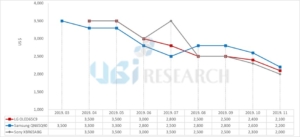
<LG Electronics’ OLED65C9, Sony’s XBR65A8G, and Samsung’s QN65Q90 price trend, Source: UBI Research DB, Bestbuy.com>
In the TV market, which is growing in size, 65-inch TVs are becoming mainstream along with 55-inch TVs. Since 55-inch OLED TVs have already formed a premium TV standard of US $ 1,500 since October, LG Electronics and Sony have continued to reduce the price of 65-inch OLED TVs, another mainstream, to compete with QLED TVs.
Since August, LG Electronics’ OLED65C9 and Sony’s XBR65A8G have formed a lower price range than Samsung’s QN65Q90, and Black Friday is also trying to get a price advantage with a price lower than QN65Q90.
LG Electronics and Sony, which are striving to popularize OLED TVs, are paying attention to whether OLED TV’s position in the premium TV market can be further expanded.
On 8 January 2018, the largest electronic show is held at Enclave Convention Center in Las Vegas, United States.
Major electronic companies such as LG Electronics, Sony, Vestel, Changhong, Skyworth presented OLED TV as main exhibition. In particular, Samsung Electronics’ “Micro LED” exhibition received a great deal of attention. Samsung Electronics unveiled the world’s first “micro LED” technology-applied 146-inch modular TV, “The Wall.” People came to see the product and it was heated up in a hot issue. Samsung Electronics emphasized that this product is a future screen that is unlimited in image quality, size and form. Through the implementation of the local dimming 3000, “The Wall”, which was unveiled at the exhibition show is developed by brightness, contrast ratio, color reproduction and black display compared to the existing display.
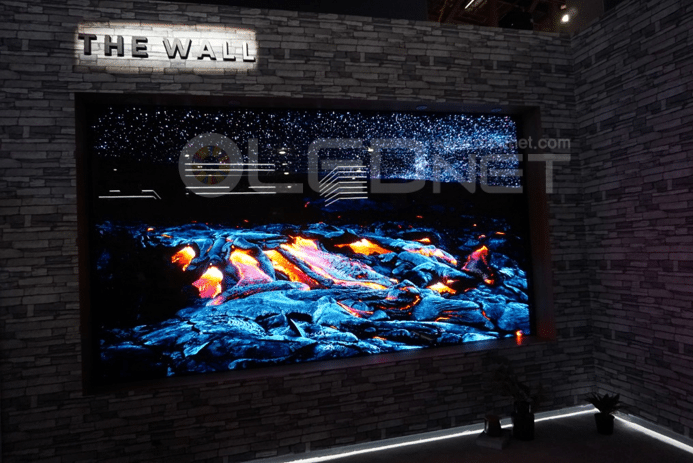
<‘Micro LED TV ‘The Wall’ of Samsung Electronics’>
Especially, the existing “Mini LED” products were exhibited along with “The Wall” for comparison of exhibition. And the excellence of “Micro LED” was outstanding. “Mini LED” products was little far from the large display as pixels and the lines of each module were shown on the screen.
LG Electronics, Sony, Changhong and other companies presented 65-inch and 77-inch OLED TV display products including Sound Acoustic OLED TV products. In particular, Konka reflected the trend that TV is a part of furniture, not just electronic products and it consists of a set design that took advantages of Chinese traditional atmosphere.
In addition, many set manufacturers have demonstrated the advantages of OLED TV, which is the lightest and thinnest through “Wall Paper TV” and “Slim” concepts.
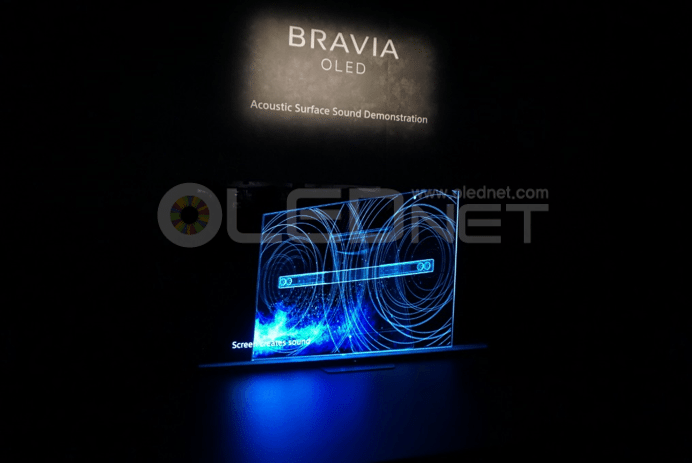
<A8F Bravia OLED TV of Sony>
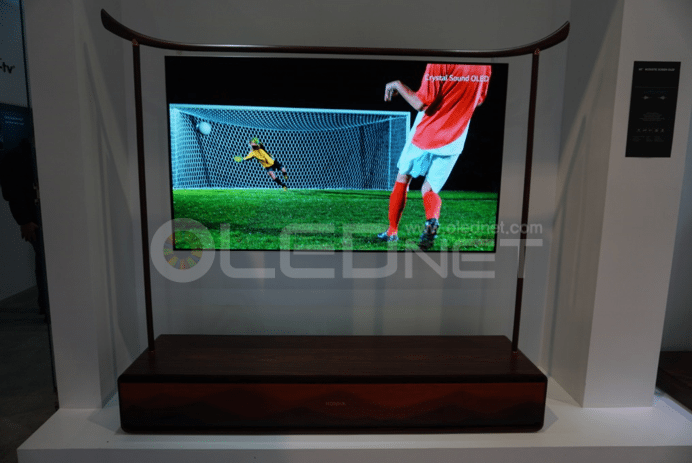
<OLED TV of Kongka>
‘TCL’, which occupies a side of QLED TV showed more advanced QLED TV in image quality and color reproduction range. According to the person in charge of TCL, QD dominated the portion of the current market therefore, many manufacturers are producing Quantum dot LCD, and also considering OLED TV launches. The person in charge emphasized that they are building factories in China that produce only OLED.
LG Electronics is a leading OLED TV company and showed OLED which is being developed continuously through making tunnels of OLED TV. They revealed that LG Electronics is the world’s first OLED TV set manufacturer. People look forward to seeing OLED growth in the future through CES the first electronic exhibition show in 2018.
TCL’s Xiaolin Yan CTO addressed solution process OLED TV and self-emitting QLED TV as premium TV after white OLED TV at iMiD 2017 keynote address in BEXCO, Busan on 29th.
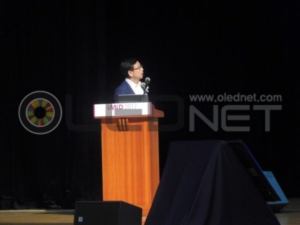
Yan CTO noted that white OLED TV, which is currently leading the premium TV market, meets all the requirements of premium TV due to its superior image quality, design differentiation, high resolution realization and nature-friendly characteristics compared to QD LCD TV.
In addition, the price that is higher than the current QD LCD TV is expected to be overcome by applying the solution process, and mass production is also expected in 2019.
Yan CTO predicted that the “solution process would be easy to produce 75-inch panels at Gen 10.5 because the process can be performed without splitting the ledger,” and “it is also possible to produce full-emission RGB OLED TVs.” However, he emphasized that the compatibility of materials and equipment and the development of ink forming process technology should be done.
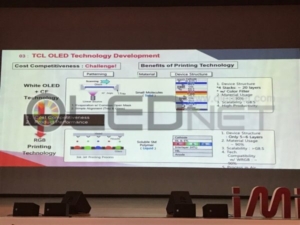
Following to that, “QLED structure is very similar to OLED structure, so it is easy to apply the technology because of the low entry barriers,” he said. “The lifetime and efficiency of the blue light emitting layer compared to the current OLED is very low, and performance must be ensured without the use of cadmium.”
Lastly, He mentioned the establishment of printing technology in Guangdong JUHUA to promote the commercialization of solution process OLED TV and self-luminous QLED TV, and emphasized the cooperation of material, equipment and panel makers to develop next-generation premium TV.
■ “Finding a new OLED market” – Discussing OLED replacement in view of OLED application development
■ Discussing new technologies of future display (LCD, QD-LCD, OLED)

The potential of future OLED development is inexhaustible as OLED can be applicable to all industries including VR / AR, automotive, aerospace, and lighting not content with smart phone and TVs. There has been growing public interest in OLED in many different industries. To meet the market demand, Ubi Research, a market research company co-hosts ‘iMiD2017 Industrial Forum’ with Korea Display Society (KIDS) in BEXCO, Busan on 30th of August.
The forum will proceed with a panel discussion among key specialists and presentation, which will enable people from many different industries to exchange information not only on the display market but also current OLED market status, technology and explore a new market potential generated in the future.
In the first session ‘look for a new OLED market’, OLED replacement will be presented in view of OLED application development. The key players include Dr. Teruo Tohma, WooSeok Jeong, principal research fellow at the Electronics and Telecommunications Research Institute (ETRI), Julian K chang, Managing director of Boeing Corporation, Professor TAKUYA KOMODA at Yamagata University, senior researcher, Michi Hisaishi, ALPINE Michihisa Onishi.
The second session, ‘Discussion of New Technologies in Future Display’ will provide insight into the latest products and technology trend of TV manufacturers competing with one another to dominate the next generation display market. Nam-Suk Oh, CEO of Samsung Electronics will present an updated LCD TV using Quantum dots technology under the title of “Quantum Dot and Advance of LCD-TV”.
In the OLED TV camp, under the title of “OLED, Now and Future”, Joon-Young Yang at LG Display will review the current status of OLED TV led by the current market trends, and also address OLED future implemented in a wide range of ‘flexible and rollable’ designs.
Weir Cao, senior researcher at TCL, will present both the technology status of the Colloidal Quantum Dots and TCL products applied to LCD in the market, under the topic of “TCL Display Technology with QDs”. The premium TV strategies are expectedly revealed. Lee Choong-hoon, CEO of Ubi research co-host of this forum, offered a time to summarize the premium TV market on the topic of ‘OLED TV market outlook by premium TV market expansion’ by analyzing the presentations of the companies that presented earlier.
For more information on the 17th iMiD2017 Industrial Forum, please visit iMiD2017 official website (http://imid.or.kr/2017/indi_forum.asp).
Consumer reports picked OLED TV of LG Electronics as the best 4K TV to buy right now, while gave QLED TV of Samsung Electronics 10th place.
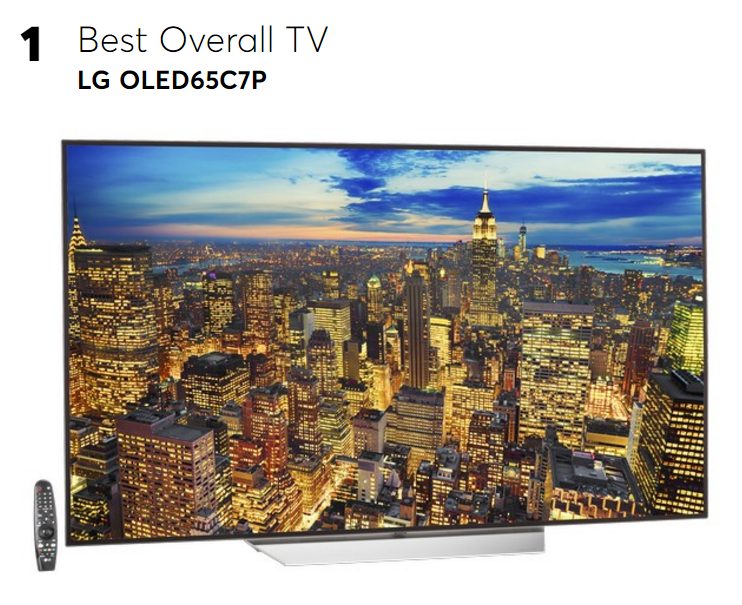
<THE BEST 4K TV LG OLED65C7P selected by Consumer Reports, Source: Consumer reports>
Consumer Reports which is a consumer magazine in US, selected OLED TV OLED65C7P of LG Electronics launched in this year as the ‘Best 4K TVs to Buy Right Now’ on 16th, since ‘OLED TV is the best for expressing black, so it can provide entirely different image quality’.
Consumer Reports evaluated that OLED65C7P has high resolution, excellent image quality and outstanding sound performance. It has the best HDR performance among the products tested this year and it will be hard to find a better TV than it.” Consumer Reports gave 88 points, the highest score ever. This is higher score than 86 points that OLED65G6P of LG Electronics received in November.
In addition, OLED65G6P of OLED TV model in 2016 of LG’s got 86 points and OLED65E6P was followed as 85 points. OLED55E6P and OLED55B6P jointly received 83 points.
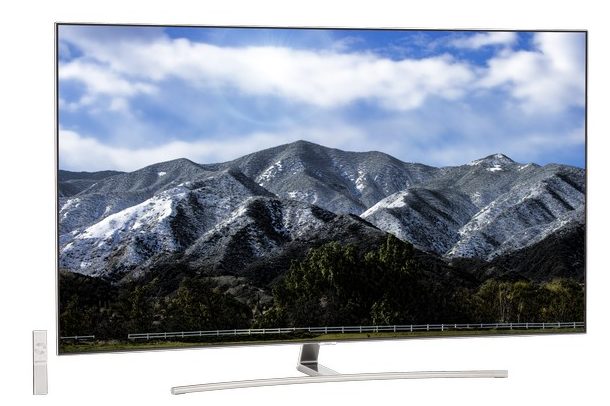
<Samsung Electronics’ QN65Q8C, Source: Consumer Reports>
QLED TV QN65Q8C of Samsung Electronics launched in this year gained 79 points. Consumer Reports explained that it is excellent in resolution, image quality, and sound quality, however there was black mark for the high price in spite of backlighting existence, limit of expression for black due to backlighting and cloud phenomenon. And Consumer Reports quoted the words of industry source that it would take more than three years for launching of true self-emitting QLED TV.
In the ‘Solution process OLED annual report’, UBi research expected that QLED deposition materials have issues on a short life-span compared to phosphorescence OLED deposition materials that are currently being commercialized, efficiency problem, development of eco-friendly devices, lack of infrastructure compared to OLED. In case of not establishing infrastructure and aggressive investment such as manpower recruitment and expansion of the development investment, the time of commercialization will be far from here.
Some line-ups of Samsung Electronics QLED TVs including the Q7 and Q8 introduced at CES 2017 are starting to be unveiled and preordered on its official U.S website and Amazon. The products for preorder are 55, 65, and 75-inch flat TVs of Q7 line-up, and 55 and 65-inch curved TVs of Q8, the higher lineup than Q7. QN65Q7F 65-inch flat TV cost US$ 3,499.99 on Amazon, as of 16th, and QN65Q8C 65-inch curved TV was US$ 4,499.99. It was 20% more expensive than ‘SUHD TV’, the premium TV line-up launched in 2016, and it was intended to build premium TV’s own image by highlighting high price range and enhanced picture quality.
On the other hand, LG Electronics OLED TV prices keep on decreasing. OLED65C6 65-inch curved OLED TV was launched last year at US$ 3,197.00 on Amazon as of 16th, and that was 50% cheaper than US$ 6,000.00 on June, 2016. In addition, the lunch price of OLED65C7 65 inch-curved OLED TV to sell this year is set as US$ 4,000.00 on Amazon as of 15th, which was a 30% cheaper than 2016 and US$ 500.00 cheaper than Samsung’s QN65Q8C 65 inch curved TV. As LG Electronics are leading the OLED premium TV market, it is likely to pay more attention to popularization due to is low price.

<Price Comparison of 2017’ 65-inch Curved TV New Products, Source : Amazon.com>
Due to similar prices of OLED TV and QLED TV in the premium TV market, high-quality picture, brand image, consumer needs satisfaction are gaining importance. Color reproduction among high-quality picture factors has similar performance, whereas OLED TV still gain a competitive advantage in contrast range and response speed. Besides, Sony that has kept a strong brand power and status in the premium TV market showcased OLED TV with higher-quality picture upgraded by ‘Acoustic Surface’ technology that produces sound without speaker and ‘X1 extreme processor’ HDR chip, attracting a lot of attention at CES 2017. Its release date and price have not yet been announced, but it is expected to greatly influence the premium TV market.
There’s a keen interest on, how the 2017 premium TV market will change due to the different price strategies of premium TVs to be released and Sony’s joining in OLED TV.
UBI RESEARCH / CEO:Choong Hoon Yi / Business License Registration Number 220-87-44660
ADDRESS: A-1901, Samho Moolsan Bldg, 83, Nonhyeon-ro, Seocho-gu, Seoul, Republic of Korea (Zip) 06775 TEL:+82-2-577-4390 / E-MAIL:marketing@ubiresearch.com
